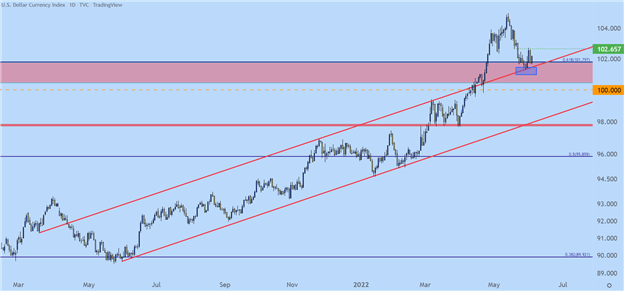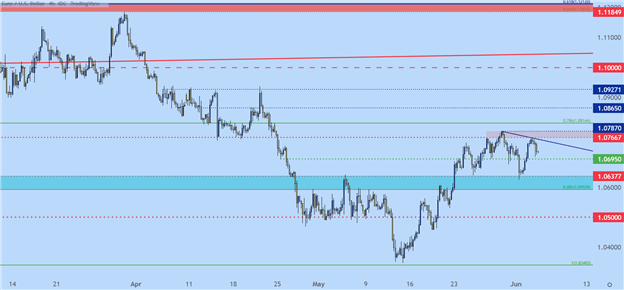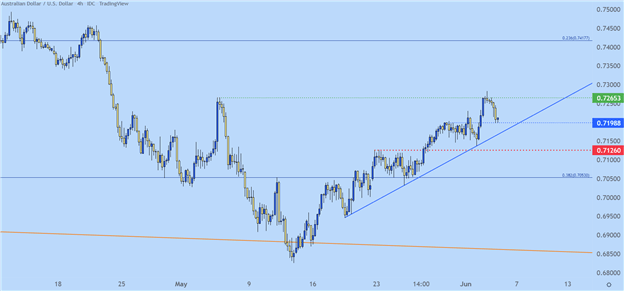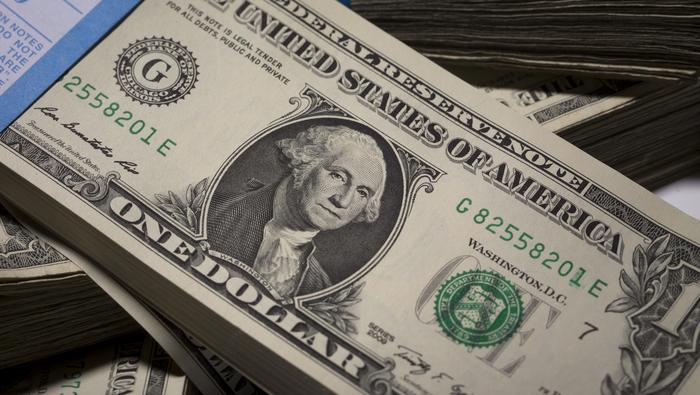US Dollar Talking Points:
- The US Dollar began last week by setting a fresh monthly low, but that led into a strong bounce that held into the end of the week.
- USD strength came back last week, helped along by dips in EUR/USD and GBP/USD. USD/JPY put in a strong topside move, signaling the return of Yen-weakness in a theme that may have some staying power. AUD/USD was the outlier, as the Australian Dollar was stronger than USD, setting up for an area of interest for counter-themes. This could also open the door for short interest in EUR/AUD or GBP/AUD along with bullish interest in Yen-pairs such as AUD/JPY and USD/JPY, or perhaps even EUR/JPY and GBP/JPY as the Yen was weaker than both the Euro and Pound last week.
- The analysis contained in article relies on price action and chart formations. To learn more about price action or chart patterns, check out our DailyFX Education section.



The US Dollar finally found some support this week. This comes after a sizable two-week sell-off that showed up just after the USD jumped up to a fresh 19-year high.
The week didn’t start with strength, however, as the Memorial day holiday on Monday saw the Dollar dip down to another fresh monthly low. Prices eventually ran into the topside of a prior bullish channel, a trendline that had previously set up as resistance for almost a full year until the bullish USD trend went into another gear in mid-April. That inflection led to a bounce on Tuesday and Wednesday and even after a quick pullback on Thursday, buyers were able to show support at the 101.80 Fibonacci level, amounting to a possible higher-low.
This gives the appearance that bullish themes in the USD may be on their way back after that two-week sell-off. And given the economic calendar, that potential appears to exist as inflation comes back into the picture next week with the Friday release of CPI, after which the focus moves to the Fed’s rate decision the following week.
US Dollar Daily Price Chart

Chart prepared by James Stanley; USD, DXY on Tradingview
EUR/USD Lower-High at Key Resistance
A big part of that pullback in the USD came from a similar pullback in EUR/USD. I had talked about this item a few weeks ago, highlighting how there was some building pullback potential in the pair given how oversold the move had become. And it took a little while for buyers to get a bit of control here, as prices found resistance at a familiar spot on the way up, plotted from 1.0593 up to 1.0638 and prices eventually bulled up to a fresh monthly high before finding resistance at the 1.0767 zone on Monday of this week.
At this point there may be some building bearish potential and I’m drawing this from the fact that after Monday, price action produced both a lower-low and a lower-high. That lower-low came-in at that same zone of prior resistance.



EUR/USD Four-Hour Price Chart

Chart prepared by James Stanley; EURUSD on Tradingview
GBP/USD
GBP/USD has a similar feel to EUR/USD above, where an oversold market put in a two-week pullback, with last week showing some signs of sellers making a return.
The difference, however, is that EUR/USD saw a bounce from the big area of support around the 1.0600 handle while GBP/USD put in a more meager move off of its support zone, plotted at around the 1.2452-1.2500 zone. I’d count this as a bit more bearish than EUR/USD above but, in both cases the more attractive bias appears to be on the side of the USD.
Next supports can be sought at 1.2380, 1.2252 and then the yearly low at 1.2153.



GBP/USD Daily Price Chart

Chart prepared by James Stanley; GBPUSD on Tradingview
AUD/USD Higher-Low Support Hold
It was another strong week for AUD/USD, much of which showed on Thursday before a pullback on Friday wiped out some of those gains. But, from a comparable basis there was a clear difference in AUD/USD versus EUR/USD, GBP/USD or even USD/JPY.
For traders that are looking for a deeper pullback in the USD, AUD/USD can remain of interest, particularly given the fresh monthly high that printed last week. This is also something that can be extrapolated into cross-pairs for traders looking to avoid the USD altogether, looking at pairs such as EUR/AUD, GBP/AUD or even AUD/JPY.



AUD/USD Four-Hour Price Chart

Chart prepared by James Stanley; AUDUSD on Tradingview
USD/JPY
It was a massive week for USD/JPY.
The pair had pulled back for three consecutive weeks and then last week, the bulk of those losses were erased as buyers bulled price right back up to resistance. This puts a bullish bias back on to the pair and the 131.25 level that held resistance in April and May is now exposed to breakout potential.
And like AUD above, this is a theme that could be extrapolated elsewhere just, on the other side, looking at the Japanese Yen for themes of weakness elsewhere. Pairs like EUR/JPY, GBP/JPY and AUD/JPY all put in very strong showings last week that give the appearance of continuation.



USD/JPY Four-Hour Price Chart

Chart prepared by James Stanley; USDJPY on Tradingview
--- Written by James Stanley, Senior Strategist for DailyFX.com
Contact and follow James on Twitter: @JStanleyFX







